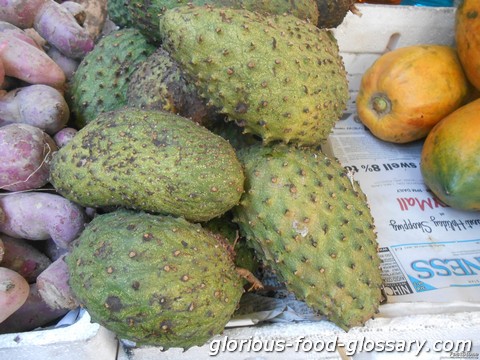Guyabano, scientifically known as Annona muricata and commonly referred to as soursop, is a tropical fruit celebrated for its unique flavor and numerous health benefits. This article explores the definition, culinary uses, potential risks, and provides a popular recipe for Guyabano smoothie. Additionally, we'll delve into the historical and legal aspects of Guyabano and list some similar fruits.
Definition and Culinary Significance: Guyabano is a green, spiky fruit with a prickly skin and soft, white flesh that contains large, black seeds. It is native to the Caribbean and Central America but is now cultivated in many tropical regions around the world. The fruit has a distinctive flavor that combines notes of strawberry, pineapple, and citrus, making it a sought-after ingredient in various culinary applications.
Culinary Uses and Popular Recipe: One of the most popular ways to enjoy Guyabano is by blending it into a refreshing Guyabano Smoothie. Here's a simple recipe to prepare this delicious and nutritious beverage:
Recipe: Guyabano Smoothie
Ingredients:
- 1 ripe Guyabano, flesh scooped out
- 1 ripe banana
- 1/2 cup Greek yogurt
- 1/2 cup coconut milk
- 1 tablespoon honey (adjust to taste)
- Ice cubes (optional)
- Place the ripe Guyabano flesh, banana, Greek yogurt, coconut milk, and honey in a blender.
- Blend until smooth and creamy. If desired, add ice cubes and blend again for a frostier texture.
- Taste and adjust the sweetness with more honey if needed.
- Pour into glasses and serve immediately.

Nutrition and Health Benefits: Guyabano is often touted for its potential health benefits. It is rich in vitamin C, fiber, and various antioxidants. Some studies suggest that Guyabano may have anti-inflammatory and anti-cancer properties, but further research is needed to confirm these claims. The fruit is also known for its potential to aid digestion and boost the immune system.
Risks and Considerations: While Guyabano offers several health benefits, it should be consumed in moderation due to its natural sugar content. Additionally, the seeds and leaves of the Guyabano plant contain compounds that can be toxic in large amounts, so they should be avoided.
Historical and Legal Context: Guyabano has a long history of cultivation in tropical regions. It has been used in traditional medicine for various purposes, including as a natural remedy for digestive issues and infections. Legal regulations regarding the sale and export of Guyabano can vary by country and may involve standards for quality and safety.
Similar Fruits:
- Cherimoya: Often called the "custard apple," it has sweet, creamy flesh and a flavor profile similar to Guyabano.
- Sugar Apple (Atis): Another close relative, it has a sweeter taste and is often eaten fresh or used in desserts.
- Custard Apple (Atemoya): A hybrid of Cherimoya and Sugar Apple, it combines the flavors of both.
Summary
Guyabano, or soursop, is a tropical superfruit known for its unique flavor and potential health benefits. Whether enjoyed as a creamy smoothie or in various culinary creations, Guyabano's delightful taste and nutritional richness make it a beloved fruit in many tropical cuisines. While it offers numerous health benefits, moderation is key due to its sugar content, and caution should be exercised regarding the seeds and leaves. With its rich history and global popularity, Guyabano continues to be a cherished addition to culinary traditions worldwide.Related Articles to the term 'Guyabano' | |
| 'Soursop' | ■■■■■■■■■■ |
| Soursop, also known as graviola, guanábana, or Brazilian paw paw, is a fruit native to the tropical . . . Read More | |
| 'Chakka' | ■■■■■■■■■■ |
| Chakka, also known as jackfruit, is a tropical fruit that has gained popularity not only for its unique . . . Read More | |
| 'Cherimoya' | ■■■■■■■■■ |
| Cherimoya is a tropical fruit known for its delicate, creamy texture and a flavor that combines the tastes . . . Read More | |
| 'Camote' | ■■■■■■■■■ |
| Camote, also known as sweet potato, is a versatile and nutritious root vegetable that plays a significant . . . Read More | |
| 'Naranga' | ■■■■■■■■ |
| Naranga, commonly known as orange, is a citrus fruit with widespread popularity in the culinary world. . . . Read More | |
| 'Thakkali' | ■■■■■■■■ |
| Thakkali, a term derived from the South Indian language of Tamil, refers to one of the world\'s most . . . Read More | |
| 'Koorka' | ■■■■■■■■ |
| Koorka, scientifically known as \'Ipomoea digitata,\' is a lesser-known tuberous root vegetable that . . . Read More | |
| 'Batuan' | ■■■■■■■ |
| Batuan is a tropical fruit primarily used as a souring agent in Filipino cuisine. This small, green fruit . . . Read More | |
| 'Cecina' | ■■■■■■■ |
| Cecina, a savory and flavorful cured meat, holds a special place in the culinary traditions of various . . . Read More | |
| 'Durian' | ■■■■■■ |
| Durian is a distinctive tropical fruit known for its strong odor, often described as pungent or even . . . Read More | |
